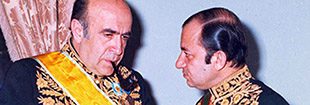Upon returning to Iran, Farshchian began working at the Directorate of Fine Arts in Tehran, a hub for the promotion and preservation of Iran’s artistic heritage. His talent and administrative skills led to his appointment as director of the National Directorate, where he oversaw various cultural projects. Concurrently, he taught at the Faculty of Fine Arts at the University of Tehran, mentoring a new generation of Iranian artists.
During this period, Iranian society was undergoing modernization under the Pahlavi government. The tension between preserving traditional culture and embracing modernity mirrored the balancing act in Farshchian’s own work—an effort to modernize the Persian miniature without losing its essence.
In 1955, Farshchian married Niadokht Ghavami. The couple had three children: Ali Morad, who later became a physician; Leila, a psychologist; and Fatemeh, whose life took a tragic turn. In the politically turbulent 1980s, Fatemeh joined the People’s Mojahedin of Iran, an opposition group. She was killed in 1988 during Operation Forough Javidan, alongside her husband, Abuzar Vardasbi. This personal loss left a profound mark on Farshchian, deepening the emotional and spiritual layers of his art.

